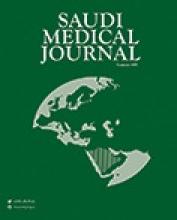Abstract
OBJECTIVE: With 20-30% of all marriages occurring between first cousins, increasing attention in Jordan is now given to role of consanguinity in the occurrence of genetic diseases. The objective of this study is to define the specific categories of genetic disorders associated with consanguineous marriages.
METHODS: Etiological categories and consanguinity rates were studied among 623 families with genetic syndromes, congenital anomalies or mental retardation, or both, seen at the National Center for Diabetes, Endocrinology and Genetics for the period August 2002 to August 2006. Comparisons were made for first cousin marriage rates in the study group and that for the general population.
RESULTS: First cousin marriages constituted 69%, 22% and 41.7% of marriages among families with autosomal recessive conditions (group 1), dominant, X-linked and chromosomal conditions (group 2) and sporadic undiagnosed conditions (group 3) respectively. The differences in rates of first cousin matings versus non-consanguineous matings were highly significant when comparing known figures in the general population with group 1 and 3, but not significant with group 2.
CONCLUSION: Two messages to the public and health care personnel regarding consanguinity can be derived from this study. The first message is that among genetic disorders, only autosomal recessive disorders are strongly associated with consanguinity. The second message is that approximately 30% of sporadic undiagnosed cases of mental retardation, congenital anomalies and dysmorphism may have an autosomal recessive etiology with risks of recurrence in future pregnancies.
- Copyright: © Saudi Medical Journal
This is an open-access article distributed under the terms of the Creative Commons Attribution-Noncommercial-Share Alike 3.0 Unported, which permits unrestricted use, distribution, and reproduction in any medium, provided the original work is properly cited.






